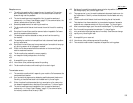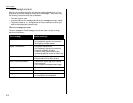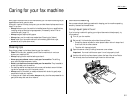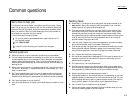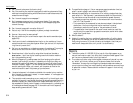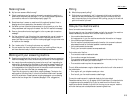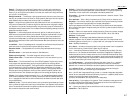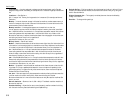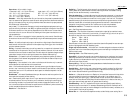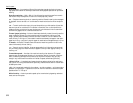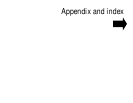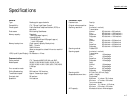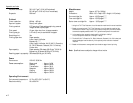
Just in case …
Default — The setting your machine will always refer to if no other action has been pro-
grammed. For example, you can set the default for this machine to send a fax by using its
memory. If you set this action as the default, that’s how your machine will always send a fax,
until you tell it to do differently.
Delayed command — Transmission or polling operation set by the user to occur later, auto-
matically, at a predetermined time. Great for reducing costs by making fax calls during times
when telephone costs are lowest, such as late at night or on weekends.
Digital — Using the binary system (which uses a combination of 0s or 1s) to describe every-
thing, so that 0 means off and 1 means on; digital fax machines convert the graphic image of
your document into a series of zeros and ones by using the binary system of transmission to
encode black and white occurrences. This increases transmission speed by passing over white
spaces. See also White-line skip.
Digital fax — Unlike analog systems that scan every portion of a document, digital fax
machines survey a document’s overall picture content. Digital fax machines scan a line and
convert the information into a binary code of zeros and ones. The fax machine takes this
information and compresses it, providing high transmission speeds. Many Muratec units
offer proprietary methods for faster transmissions between Muratec-manufactured units (see
also
MSE
,
SMSE
).
DIP
switches — Dual in-line package switch; a two-position on/off switch. Many Muratec fax
machines include
DIP
switches to control optional settings or features.
Document feeder — The adjustable slot into which users place documents for faxing or
copying.
Document mode — It can be said the resolution. (See Resolution.)
Effective printing width — The widest image that can be printed on a fax.
Effective scan width — The maximum width the scanner in a fax can scan during trans-
mission.
E
NERGY
S
TAR
®
— The International E
NERGY
S
TAR
®
Office Equipment Program is an interna-
tional program that promotes energy saving through the penetration of energy efficient
computers and other office equipment. The program backs the development and dissemina-
tion of products with functions that effectively reduce energy consumption. It is an open
system in which business proprietors can participate voluntarily. The targeted products are
office equipment such as computers, monitors, printers, facsimiles, copiers, scanners, and
multifunction devices. Their standards and logos are uniform among participating nations.
F-Code — A fax-industry standard created by the
ITU
-
T
for sub-addressing/password-based
communications. Because F-Code is an industry standard, Muratec fax machines as well as
all
ITU
-
T
equipped fax machines from other manufacturers can communicate with each other
using sub-addressing.
Facsimile (or fax) — A form of communication involving the scanning and decoding of a docu-
ment into electrical signals and transmitting of the document, over telephone lines to another
device.This device then reconstructs the signals to produce an exact duplicate of the document.
Also, a machine that performs such communication.
Fallback — Group 3 fax machines operate at the highest transmission speed possible on a
given telephone line. Muratec systems offer automatic fallback; if line quality drops during
transmission, the fax machine will reduce speed to the fastest possible level.
File number — A number the machine gives to each document it stores for a batch, F-Code
or polling operation.
Fine resolution — 203
H
× 196
V
lpi. Also shown as
G
3
F
(“Group 3 fine”) on some fax units.
Grayscale — Not a level of resolution, but a method of scanning and transmitting halftone
images. Fax machines with grayscale abilities interpret photographs in
levels of gray between white and black. The transmitting fax machine must have grayscale
ability to send a photographic image accurately, but the receiving machine does not need it to
print the image.
Group 3 — Refers to fax machines that use digital encoding. These units transmit one page
in less than one minute and produce resolution of 203 × 98, 203 × 196, or 203 × 392 lpi.
Halftone — See Grayscale.
Handshaking — An exchange of data between telecommunications and/or
computer equipment that “introduces” two systems to each other. For example, faxes use a
handshaking protocol to identify the
ITU
-
T
group of each unit and to begin fax communication.
Hub — See Relay broadcasting.
Hz (or Hertz) — A measure of frequency equal to one cycle per second. Used in the specifica-
tions for a fax machine, it identifies the
AC
power the unit requires.
ITU
-
T
— International Telecommunications Union – Telecommunications Sector. (Formerly
known as
CCITT
, for Consultative Committee for International Telegraph and Telephone.) A
telecommunications forum for member countries of the United Nations whose Study Group
XIV
established the primary groups for fax equipment, covering communication protocol and
transmission. Muratec Group 3 fax machines offer the fastest transmissions allowed by the
ITU
-
T
when communicating with other Group 3 units.
ITU
-
T
Test Document 1 — Also called the Slerexe (“slehr-rehks”) letter; An
ITU
-
T
standard
document with a known black density which fax makers often use to test transmission
speeds of their fax machines. Published transmission speeds are also based on this document.
ITU
-
TV
.29 and
V
.27 ter. — A standard set of communication procedures allowing fax
machines to talk to all other units adhering to those standards.
JBIG
— Joint Bi-level Image experts Group, the new
ITU
-
T
standard image data compression
method. As
JBIG
compresses the data more efficiently than
MMR
, it is especially effective when
transmitting halftone (grayscale) image document.
(Of course, the compression ratio may vary with the image data.)
Laser printing — A plain-paper printing system. Toner is attached to a charged drum and
an image is transferred onto plain paper through electrical currents, then fused with heat
and pressure to produce a dry, permanent printout.
LCD
— Liquid crystal display. Used on some Muratec units for status displays.
Leased line — See Private line.
5.17



